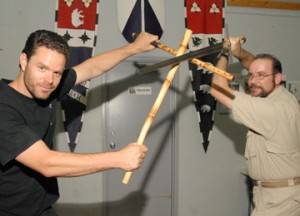
It’s the perfect example of a blended family.
Four very different martial arts in one facility has made for a strengthened relationship, and a great way to follow the philosophy of martial artist Bruce Lee.
“Absorb what is useful, reject what is useless, add what is specifically your own,” Lee once said.
It’s something that Fighting Arts Collective Toronto takes to heart, says Jeet Kune Do instructor Shawn Zirger.
“We’re willing to work with people instead of being in isolation and that we’re not system-centric,” he adds. “We learn from each other.”
FACT started in March 2002 when Zirger and friend Leon Samadi started training medieval martial art enthusiasts Brian McIlmoyle and David Cvet in grappling.
The quartet bonded and expanded to a larger facility in the Dupont and Ossington area, accommodating the 14th-century art Armizare, jeet kune do and later Wing Chun kung fu, taught by Ryan Kennedy.
Since then, the group has grown to include the Russian martial art systema and firearms training through the Toronto Tactical Airsoft Combat College, which uses plastic pellets as ammunition.
The expansion has had a positive effect, allowing students from all schools to cross-train.
“(FACT) has become a much stronger thing than just space sharing,” Zirger says of the union between schools. “We’re actually helping to perform and broaden our perspective.
“We’re starting to see how the Asian martial arts, the modern Western martial arts, European martial arts have all impacted each other and keeps it all really relevant.”
While the environment encourages cross-training, it also alters students’ perspectives of martial arts for the better, adds Zirger.
“People come in with some preconceived notion of what they are going to do that will generate self-discipline, self-respect, self-esteem,” he says. “Then they look across the room seeing what other people are doing and that’s when you start seeing people cross-training.”
Even the firearms class has gone from a desire to shoot targets to figuring out how to not pull their guns out at all.
“They’re looking to a broader perspective of what martial arts training really is,” Zirger says. “(It’s) preparing yourself to not have to deal with violence, to be able to avoid it or to be able to negotiate a better alternative.
“It’s a really viral kind of mentality because people see the value and it’s all about sharing,” he adds. “No one is refused or denied.”
